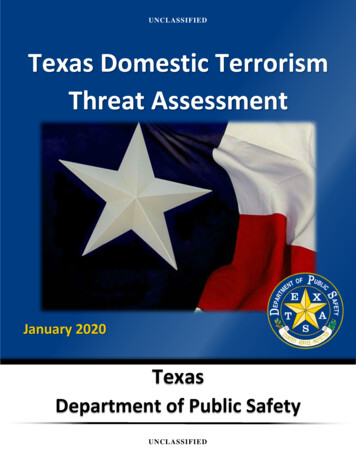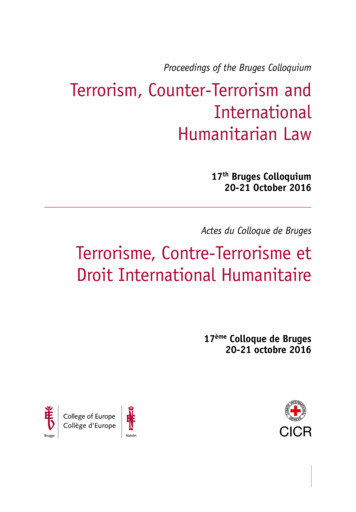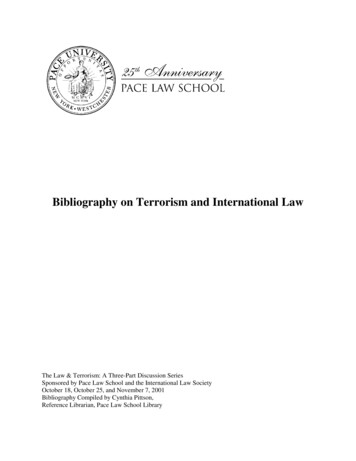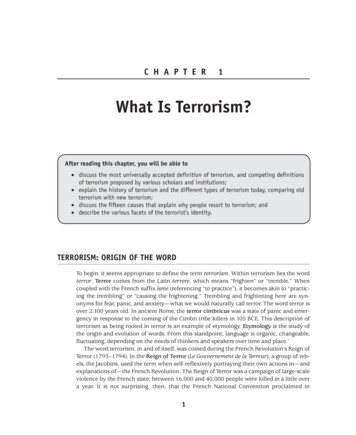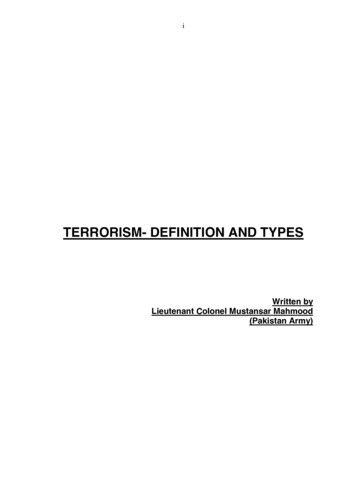
Transcription
iTERRORISM- DEFINITION AND TYPESWritten byLieutenant Colonel Mustansar Mahmood(Pakistan Army)
iiABSTRACT OF RESEARCH PAPER ON “TERRORISM- DEFINITION ANDTYPES”Today, terrorism is one of the major threats, being faced by most of theworld states. Unfortunately, absence of an agreeable definition is a majorobstacle to meaningful international counter measures. An internationallyacceptable definition is essential for effectively combating terrorism and forformulation of anti-terrorism laws.During research, it is found that prevailing definitions are incomprehensive,vague, biased, and are based on self-interests of the state by which thedefinitions are given. These definitions do not differentiate between the freedomstruggles/national liberation movements and terrorism. Definitions, which do allowpursuance of freedom struggles and guerrilla movements, are so ambiguous thatthese are likely to be exploited by the terrorists in the name of freedom struggles.For example, as per the definition proposed by the United States of America, actsof violence against civilians by the states may be the violations of internationallaw but is not terrorism. It is feared that the prevalent concept of terrorism willaffect all freedom struggles / movements of national liberation, being waged indifferent parts of the world.However, fortunately, everyone agrees that indiscriminate terror, use of force forpolitical, social, ethnic, economic and religious purposes, can never, in principle,be morally justified, whether committed by an individual, group, community or astate. This agreement will help to reach an acceptable definition and it isrecommended that a comprehensive discussion be organized under the UnitedNations and definition be finalized, keeping aside the self-interests.
iiiFurthermore, in the absence of agreed definition and international laws, manystates are involved in state terrorism and are also sponsoring the same. Force isbeing used to suppress the basic human rights of freedom and that of social andeconomic justice. Due to globalization, social and economic injustice, totalitarian,religious and ethnic intolerance etc, various types of terrorism, such as, religious,anarchist, right wing, left wing and nationalist terrorism are on the increase. Infuture terrorist engagements, use of NBC resources and suicidal missions arelikely to be the common phenomenon.
ivTABLE OF CONTENTS1.Introduction2.Part-1: Definitions of Terrorism1a. Importance of defining terrorism3b. Prevailing definitions of terrorism5c. Analysis7(1) Analysis of prevailing definitions7(2) Various perspective about prevailing definitions9(3) Complexities involved in defining terrorism12d. Conclusions from the analysis and perspectives ofprevailing definitions.e. Proposed definition and its acceptability13153. Part-2. Types of Terrorisma. State terrorism17b. State sponsored terrorism17c. Nationalist terrorism19d. Religious terrorism19e. Left and Right wing terrorism21f. Anarchist terrorism21g. Suicide terrorism22h. NBC terrorism23i.Cyber terrorism234. Part-3: Recommendations25
1TERRORISM-DEFINITION AND TYPESINTRODUCTION1.The terrorist attack on World Trade Center and Pentagon has given a newdimension to terrorism. The manner, in which the terrorist attack was launched,had shaken the entire world in general and United States of America in particular.The tragic event evoked a quick and united response from the world communityunder the umbrella of United States of America. However, consequently, thelabeling of various organizations and groups as terrorists and the absence of anagreeable definition has complicated the problem of a united and effectiveresponse.2.The statement, “One man‟s terrorist is another man‟s freedom fighter,” hasonce again come into limelight. The statement has become not only a cliché, butalso one of the most difficult obstacles in coping with terrorism. In the struggleagainst terrorism, the problem of definition is a crucial element in the attempt tocoordinate international collaboration, based on the currently accepted rules oftraditional warfare.3.The question of a definition of terrorism has haunted the debate amongstthe states for decades. A first attempt to arrive at an internationally acceptabledefinition was made under the League of Nations, but the convention drafted in1937 never came into existence. The UN Member States still have no agreedupon definition.4.In addition to the problem of an internationally acceptable definition, theevents of September 11 have shown the new dimensions of terrorism. Statebacked terrorism of the 1970‟s and 1980‟s, which grew out of observable andpublicized protest movements, has mostly been joined or replaced by the new
2terrorism. Its development at the micro level is more difficult to observe andanalyze. The process that resulted in the political or religious extremist evolvinginto a terrorist has been foreshortened by easy access to technology and themateriel required committing the act of terror. It is now evident that terrorism hasmany forms/types and it can be executed in a variety of ways, usingunimaginable means. The understanding of the various types of terrorism andmethods of execution of terrorist acts is essential for evolving a suitable counterterrorism strategy.5.In short, an internationally acceptable and agreeable definition isnecessary for a united and just response to the terrorist acts, wherever,whenever and by whomsoever these are executed. Similarly it is absolutelyessential to understand the various types of terrorism and motive behind eachone of these, for giving a viable response to these terrorist acts.AIM6.To analyze prevailing definitions of terrorism and its various types, with aview to propose a viable definition and offer few suggestions in this regard.
3PART-1: DEFINITIONS OF TERRORISMGeneral7.Scholars, politicians, security experts and journalists, all use avariety ofdefinitions of terrorism. In their book Political Terrorism, Schmidt and Youngmancited 109 different definitions of terrorism. However, certain issues in thedefinition of terrorism still remain unresolved, some are1: a.The boundary between terrorism and other forms of politicalviolence.b.Separating “terrorism” from simple criminal acts.c.The relationship between guerilla warfare and terrorism.Importance of Defining Terrorism28.Defining terrorism is not merely a theoretical issue but an operativeconcern of the first order. Without answering the question of “what is terrorism”,no responsibility can be imposed on countries supporting terrorism or involved instate terrorism, nor can steps be taken to combat terrorist organizations and theirallies.9.In fact, the need for a definition of terrorism can be seen at almost everyphase of contending with terrorism (diagram 1 below). Such phases include: a.International Cooperation. An internationally accepted definitionof terrorism is required to strengthen cooperation between countriesin the struggle against terrorism and to ensure its effectiveness.b.Legislation and Punishment. A definition of terrorism is necessaryfor making laws, designed to ban terrorism and assistance to1Boaz Ganor. An article “Is One Man’s Terrorist is Another Man’s Freedom Fighter”. [Online]Available http://www.ict.org.il/articles/define.html. 22 Jul 2002.2ibid
4terrorism, as well as when setting minimum sentences for terroristsor confiscating their financial resources and supplies.IMPORTANCE OF DEFINING TERRORISMDefinition of sActions against statessupporting terrorismCooperativemilitaryoperationsLegislative andPunitive actionsDistinguishingterrorismfrom freedom fightingInternationalsupport formilitaryoperationsInternationallaws &treatiesSettingsentencesfor of terrorismDistinguishingterrorism fromcriminal activityFreezing offinancialassetsEducationAttitudes towards popularsupport of terrorismDistinguishingterrorism fromguerilla activityDelegitimizingterrorismRealigningthe “rules ofthe game”Cooperative action against terroristorganizationsDiagram 1c.States Sponsoring Terrorism. States sponsoring terrorism useterrorist organizations as a means to their own ends. Terroristorganizations depend on the assistance they receive from suchcountries at the economic, military and operational levels. It isimpossible to contend effectively with terrorism without severing theclose tie between the terrorist organizations and the sponsoring
5states. This tie, however, cannot be severed without agreeing on abroad definition of terrorism.d.Distinguishing between Terrorism and Freedom Struggles. Aninternationally accepted definition of terrorism is required that willdistinguish freedom fighting (which enjoys a measure of legitimacyamong nations) from terrorist activity.Prevailing Definitions of Terrorism10.League of Nations Convention (1937). In this convention terrorism wasdefined as, “All criminal acts directed against a state and intended or calculatedto create a state of terror in the minds of particular persons or a group of personsor the general public"3.11.A terrorist action involves violence, or force, or threat of force as a methodof combat directed towards some political end. That end may be achievedthrough coercion, extortion, intimidation, or induction of compliance in some areaof policy, addressed to a government, organizations or third parties. It isessentially criminal in character, where civilians, non-combatants, non-resistant,neutrals, or outsiders are the principal victims4.3456712.Terrorism is a violent act aimed at influencing the political process5.13.Terrorism is a political struggle, which operates by means of crimes6.14.Terrorism is such a crime which is characterized by7: a.It has no organic connection with legitimate warfare.b.It has inhumane element.UN Office for Drug Control and Crime Prevention. Under the subject,” Definitions of[Online] Available http://www. odcp.org/terrorism-definitions.htmlMaxwell Taylor, The Terrorist, under the subject, “A Form of Definition”, page (P) 70.Maxwell Taylor, The Terrorist, under the subject, “A Form of Definition”, P.3.Henry Hyunwook Han, Terrorism, Political Violence and World Order, P.5.Henry Hyunwook Han, Terrorism, Political Violence and World Order, P.6.Terrorism”.
615.Terrorism is an anxiety-inspiring method of repeated violent action,employed by semi- clandestine individual, group or state actors, for idiosyncratic,criminal or political reasons. The immediate human victims of violence aregenerally chosen randomly or selectively from a target population, and serve asmessage generators8.16.United States Definition. United States Code defines terrorism as,”premeditated, politically motivated violence perpetrated against noncombatanttargets by sub national groups or clandestine agents, usually intended toinfluence an audience”9.17.EU Definition. Terrorist offences, include intentional acts, by their natureand context, which may be seriously damaging to a country or to an internationalorganization, as defined under national law, where committed with the aim of 10: a.Seriously intimidating a population, orb.Unduly compelling a government or international organization toperform or to abstain from performing any act, orc.Destabilizing or destroying the fundamental political, constitutional,economic or social structures of a country or internationalorganization.18.Terrorism Research Center11. Terrorism research center of US hasquoted following definitions given by various scholars and experts: a.Terrorism is the use or threatened use of force designed to bringabout political change. Brian Jenkins891011Same as footnote 4 above.Title 22 of the United States Code, Section 2656f (d).Article 1 of the political agreement on the framework of decisions on combating terrorism. [Online]Available htmTerrorism Research Center. Under the subject” Definitions”, [Online] tml
7b.Terrorism constitutes the illegitimate use of force to achieve apolitical objective when innocent people are targeted. WalterLaqueurc.Terrorism is the unlawful use of force or violence against persons orproperty to intimidate or coerce a government, the civilianpopulation, or any segment thereof, in furtherance of political orsocial objectives. FBI Definition19.Organization of Islamic Conference’s (OIC) Proposed Definition.Terrorism is an act carried out to achieve an inhuman and corrupt objective,involving threat to security of any kind and violation of rights acknowledged byreligion and mankind.Diagram 2Analysis20.Analysis of Prevailing Definitionsa.Double Standards. There is a vast amount of hypocrisy on thesubject of terrorism. We all condemn it, except where our friends or
8we are engaging in it. Then we ignore it, or gloss over it, or attach toit tags like “liberation” or “defence of the free world” 12.b.OIC’s Definition. As per OIC, the fact that an operation is violentdoes not constitute a condition for considering it a case of terrorism.It necessitates ascertaining the nature of one act or another todetermine whether it is a case of terrorism or not, which is notpracticable. However definition does cater for the following: (1)Acts of national resistance exercised against occupyingforces and colonizers, which are recognized by internationalcommunity, e.g., struggle of Palestinian against Israelioccupation forces.(2)Retaliation against any aggression if there is no otheralternative.c.EU Definition The definition does not impose any restriction onfreedom struggles/national liberation movements. However it is toobroad and does not lead to any specific actions against terrorists.d.United States Definitions. The definitions proposed by variousdepartments and United States law, does not include acts ofviolence against civilians that are committed by the military forces ofrecognized states, but only those by individuals or non-stateorganizations. According to the U.S. violent acts by states might beviolations of international law but are not terrorism. The violencecarried out by the Israeli armed forces, that deploy suchdisproportionate firepower, tanks, helicopters and F-16s in civilianneighborhoods is not terrorism. Israel is using the consequent12Maxwell Taylor, The Terrorist. P 3.
9violence for what is internationally recognized as an illegitimatepurpose i.e., the maintenance of its occupation and the Palestiniansare using it for what is recognized as a legitimate one i.e., theending of the occupation.e.Both state and non-state organizations can be involved in terrorism.Most countries in the world have the potential for undertakingterrorism whenever they become involved in violent acts aimed atinfluencing the political process (in suppressing a demonstration, forexample). We do not usually think in these terms, of course, and weprefer to reserve the term terrorism for those states of which wedisapprove13.f.There are abundant historical example of terrorist acts beingperformed by the civil, military, or security forces of liberaldemocratic states (for example, by certain French interrogators andpolicemen in Algeria, by certain U.S. soldiers and units in Vietnamand by certain individual members of British security forcesoperating in Africa and south east Asia).g.If terrorism is defined strictly in terms of attacks on non-militarytargets, a number of attacks on military installations and soldiers'residences could not be included in the statistics.21.Various Perspective About Prevailing Definitionsa.Freedom struggle/National Liberation versus Terrorism. Theprevailing definitions do not distinguish between the terrorism andlegitimate and internationally recognized freedom struggles, evenwhen these are aimed at obtaining independence from foreign13Maxwell Taylor, The Terrorist, under the subject, “Who Undertakes the Terrorism”, P.6.
10occupation. The atrocities, being committed by the occupationforces and government machinery, are ignored and any retaliatoryaction of the sufferer is labeled as terrorist act. The Kashmir andPalestine are the glaring examples. The following major differencesbetween the two concepts need due attention before finalizing anydefinition.(1)Freedom Struggles(a)It is a struggle that encompasses both political ion/independence, as against terrorism,where violence is the only mean employed to achievethe goal.(b)It does not resort to indiscriminate killing of civilian. Interrorism civilians are the main targets and violence isused for indiscriminate killing of people/destruction ofproperty.(2)Muslim world reiterates its absolute faith in the need todistinguish the brutal and unlawful terrorist activitiesperpetrated by individuals, by groups, or by states, from thelegitimate struggle of oppressed and subjugated nationsagainst foreign occupation of any kind.b.Terrorism or Self-defence.All attacks on Israeli, s civilians,including those by Palestinian suicide bombers does not constituteterrorism, as many Arab states regard such acts as legitimate selfdefence.
11c.Terrorism versus Guerrilla warfare14 It is feared that the prevalentconcept and understanding of terrorism will affect all the guerillamovements being waged in the different parts of the world. It isessential to differentiate between the two entirely different concepts.(1)Paul Wilkinson distinguishes between terrorism and guerrillawarfare by stressing, “Guerrillas often do fight according toconventions of war, exchanging prisoners and respecting therights of non-combatants. Terrorists place no limits on meansemployed and frequently resort to widespread assassination,the waging of „general terror‟ upon the civilian population.14Boaz Ganor. An article “Is One Man’s Terrorist is Another Man’s Freedom Fighter”. [Online]Available http://www.ict.org.il/articles/define.html,22 Jul2002.
12(2)If an attack deliberately targets civilians, then that attack willbe considered a terrorist attack, whereas, if it targets militaryor security personnel then it will be considered a guerrillaattack. It all depends on who the intended victims are. Referto Diagram 3 above.22.Complexities Involved in Defining Terrorisma.Labeling Opponents as Terrorists15. Every international bloc,every state or indeed every community has enemies and opponentsthat seek to eliminate it, and, as the conflict becomes violent, eachparty tries to undermine the reputation of the other by attributing toit repulsive epithets, such as "anarchist", "criminal", “inhuman","terrorist", and the like. We may even find that each of the twoparties indulges in such allegations in order to carry out a plan,which involves the deprival of the other party of its rights on thepretext of collaborating with the enemy or plotting against lawfulinterests.To materialize this process, each party uses itsinternational influence in order to win other parties over to its sideeither in action or in terms of support in international foray.Accordingly, feelings are influenced and sentiments are exploitedfor the implementation of such plans motivated by self-interest,under the banner of "anti-terrorism" for instance.b.Terrorizing People. For those who accept that terrorism is aboutterrorizing people, other questions arise. Does it include threats, aswell as actual violence? A few years ago, for example, the Islamic15Ayatullah Muhammad Ali Tashkri, an article, “The Definition of Terrorism” in Al- Tawhid: AJournal of Islamic Thought and Culture. [Online] Available on http://www.al islam.org/search/index.html
13Army in Yemen warned foreigners to leave the country if theyvalued their lives but did not actually carry out its threat.c.Distinguishing between Terrorism and Warfare. The statedepartment regards attacks against "noncombatant targets" asterrorism but the "noncombatants" includes both civilians andmilitary personnel who are unarmed or off duty at the time. In anarticle written by Brian Whitaker, following observations were made16:-(1)The most lethal bombing in the Middle East was the suicideattack on USS Cole in Aden harbour, which killed 17American sailors and injured 39 more. As the ship wasarmed and its crew on duty at the time, why is this classifiedas terrorism?(2)A similar question arises with Palestinian attacks on Israelisettlements. Many settlers are armed (with weaponssupplied by the army) and the settlements themselves though they contain civilians - might be considered militarytargets because they are there to consolidate a militaryoccupation.Conclusions from the Analysis and Perspectives of Prevailing Definitions23.It does not differentiate between the freedom struggles and terrorism. It isfeared that the occupation forces of the states will exploit the present concept ofdefinition, and freedom struggles will be crushed in the shade of terrorism. The16Brian Whitakar, an article, “The Definition of Terrorism”. [Online] alists/story/0,7792,487098,00.html
14ambiguity is also likely to be exploited by the terrorists i.e., they will committerrorist acts in the name of freedom struggles.24.It does not lay a clear line between the terrorism and guerilla warfare,which will be used by the states for suppressing the normal guerilla movements.25.Terrorist organization may make an attempt (Israel, USA and India etc feelthat it is an attempt by terrorist) to justify the “means” (terrorism) in terms of the“end” (national liberation).26.Terrorism is not, necessarily confined to clandestine groups, and if we seethe term as referring to the attributes of certain kinds of acts, then of agencies,including states agencies, can show evidence of terrorist behavior17.27.Common characteristics to all forms of terror are unpredictability,indiscriminateness and ruthless destructiveness.28.Indiscriminate terror can never, in principle, be morally justified. Butconversely many acts of rebellion, insurgency, and regular or irregular war whichdo not involve indiscriminate terrorization of the population, and which may beshown to be morally justified, are often labeled as terrorist acts by opposingparties.29.The definition does not require that the terrorist organizations accept it assuch. Nevertheless, reaching international agreement will be easier the more thedefinition takes into account the demands and viewpoints of terroristorganizations and their supporters18.30.We must not be so absorbed in the horror and challenge of terrorism thatwe forget or ignore the circumstances that gave rise to it, and sustain it.17Maxwell Taylor, The Terrorist, P.40.Boaz Ganor. An article “Is One Man’s Terrorist is Another Man’s Freedom Fighter”. [Online]Available http://www.ict.org.il/articles/define.html,22 Jul2002.18
1531.The idea that one person‟s „terrorist‟ is another‟s „freedom fighter‟ cannotbe sanctioned. Freedom fighters or revolutionaries don‟t blow up busescontaining non-combatants; terrorist murderers do. Freedom fighters don‟t set outto capture and slaughter school children; terrorist murderers do.32.General consensus which emerges is that indiscriminate terror, use offorce for political, social, ethnic, economic and religious purposes, can never, inprinciple, be morally justified, whether committed by an individual, group,community or a state.Proposed Definition33.Keeping in view the analysis and conclusions, terrorism can be defined onthe following lines: a.It is the unlawful use of force and violence against personnel andproperty by an individual, group, community or a state forintimidating the opposition for political, social, ethnic, economic andreligious purposes. It involves following: (1)Indiscriminate killing of civilians.(2)Indiscriminate killing of security forces/armed forces of acountry, which are not the occupation forces.(3)Indiscriminate killing of security forces/armed forces of acountry, which are occupation forces but which are not usingthe violent means (terrorism) to suppress the freedomstruggles.(4)Indiscriminate destruction of buildings /infrastructure andother resources of the states, which are meant for thewelfare and development of general public.
16(5)Atrocities, mascaras, genocides and brutalities committed bythe armed forces/ security forces of the states, against itsown people and freedom fighters with a view to suppressthem.b.Acceptability of Proposed Definition and its Analysis(1)It includes individual, group, community or a state, so anyone involved into terrorist acts can be brought to justiceunder the international law/conventions of anti-terrorism.(2)It allows the perusal of freedom struggles and movements iscriminate killing of humanity, especially the civilians.(3)It does not impose any restriction on the guerilla movements,which are directed against the specific military targets.
17PART-2: TYPES OF TERRORISMState Terrorism34.Use of violence by states in the furtherance of political ends. Stateagencies, just as much as secret societies or dissident groups commit terroristacts in an attempt to produce or maintain political objectives19.35.Terrorism used by states for repression of their own citizens, politicalopponents, and minorities, as well as against conquered peoples and enemies inwar20.36.Example of State Terrorisma.Mivtah Elohim, an Israeli-government specialist terror squad thatraided Beirut in April 1973 and killed three Palestinian guerrillaleaders and over a dozen other people21.b.Most recent examples of state terrorism can be seen in IndianOccupied Kashmir and in Palestine. With the brutal use of force,both, Israel and India are trying to suppress the movements ofindependence and self-determination respectively.State Sponsored Terrorism37.State-sponsored terrorist groups are deliberately used by radical states asforeign policy tools—as Hoffman puts it, as "a cost-effective way of waging warcovertly, through the use of surrogate warriors or 'guns for hire22.38.Acts of terrorism sponsored and launched by one country against anotherusing violence and lethal force with a view to achieving long term political orstrategic objectives. The aim of the country, which sponsors and abets terrorism19202122Maxwell Taylor, THE TERRORIST, P.41Paul Wilkinson, Political Terrorism, P.22.Paul Wilkinson, Political Terrorism, P.23.Council of Foreign Relations, under the subject,” Terrorism”. [Online] /types.html
18and insurgency, can range from destabilization and weakening of a governmentor a central authority to the break up of the existing social and political order, inthe targeted country23.39.Examples of States Sponsoring Terrorisma.According to State Department Iran is the primary state sponsoringterrorism. It also accuses Cuba, Iraq, Libya, North Korea, Sudanand Syria of sponsoring terrorism24.b.RAW, Indian intelligence agency, sponsor terrorist acts in Pakistan.c.India blames ISI for sponsoring terrorism in Indian Held Kashmirand in India.Nationalist Terrorism40.Nationalist terrorists seek to form a separate state for their own nationalgroup, often by drawing attention to a fight for "national liberation" that they thinkthe world has ignored. Nationalist terrorism can be difficult to define, since manygroups accused of the practice insist that they are not terrorists but freedomfighters25.41.Examples of Nationalist Terrorist Groups. Nationalist terrorist groupsinclude the Irish Republican Army and as per Israel the Palestine LiberationOrganization. Others are the Basque Fatherland and Liberty, which seeks tocreate a Basque homeland separate from Spain, and the Kurdistan Workers'Party, which seeks to create an independent Kurdish state apart from Turkey.23Major General Afsir Karim, avsm (retd), Counter Terrorism The Pakistan Factor, P.124Henry Hyunwook Han, Terrorism, Political Violence and World Order, P.32.25Henry Hyunwook Han, Terrorism, Political Violence and World Order, P.174and [Online] Available ml
19Religious Terrorism42.Religious terrorists seek to use violence to further what they see asdivinely commanded purposes, often targeting broad categories of foes in anattempt to bring about sweeping changes. Religious terrorism is characterized bycompliance with belief. Sectarian killings, as practiced both by Nationalists andLoyalists in Northern Ireland fall into this category. As Hoffman puts it, religiousterrorists can use limitless violence against an open-ended category of targets,that is, anyone who is not a member of the terrorist‟s religion or religious sect26.43.Examples of Religious Terrorist Groups. According to state departmentof America, religious terrorist groups include Osama bin Laden's al-Qaedanetwork, the Lebanese Shiite group Hezbollah, the radical Jewish groupsaffiliated with the late Rabbi Meir Kahane etc.Left Wing Terrorism44.Left-wing terrorists are out to destroy capitalism and replace it with acommunist or socialist regime. The Baader-Meinhof Group (Germany), theJapanese Red Army, the Weathermen (1970s America), and the Red Brigades(Italy) are examples of left-wing terrorist groups27.Right Wing Terrorism45.These groups seek to do away with liberal democratic governments andcreate fascist states in their place28. In February 2001, 200 members of Russia‟slargest ultra-nationalist group marched in the capital with their Nazi-stylearmbands and stiff-armed salutes on display. Though it does not threaten the26Paul Wilkinson, Political Terrorism, P.45 and [Online] /types.html27Council of Foreign Relations, under the subject,” Terrorism”. [Online] /types.htmlibid28
20population at large, right-wing terrorism, enha
ii ABSTRACT OF RESEARCH PAPER ON "TERRORISM- DEFINITION AND TYPES" Today, terrorism is one of the major threats, being faced by most of the world states. Unfortunately, absence of an agreeable definition is a major
